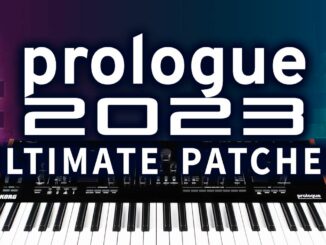Moog expands its 60HP instrument range with the Labyrinth, a new semi-modular synth that explores two coasts in fascinating, generative ways.
Since the big leak at Superbooth 24, it was known that Moog had another 60HP semi-modular Synthesizer in the pipeline. Then, the first unplanned sound demos followed, and so they did the first announced official release without surprising effect. Today is the day.
Moog has today released the Labyrinth, its fifth analog Synthesizer in its popular 60HP instrument range. The Labyrinth is probably the most experimental 60HP the company has released.
At this point, I have to say that the delivery of my Labyrinth was delayed. So I can’t tell you all the details and patch ideas. That will follow in the review and video.
Moog Labyrinth
The Moog developers have created something experimental and special for their new release. It is not a classic semi-modular subtractive synth voice. That’s for sure.
Labyrinth is semi-modular and offers an intriguing voice inspired by classic percussion synthesizers. It has two oscillators: a sine wave VCO and a triangle VCO. You can also archive through-zero frequency modulation. From here, it goes into a mixer with saturation, a ring mod option, and a noise generator.
Then, the mixer splits the signal into two different signal paths: one goes into a newly developed voltage-controlled wave folder with bias control, the other goes into a voltage-controlled state variable filter with lowpass and bandpass.
A highlight is the interaction between the signal paths. In addition to the parallel option with blend control, you can route the wave folder into the VCF or vice versa, giving you different sonic options.
So seen Labyrinth gives you two coasts in one synth to explore. Classic subtractive with a filter, but additive, i.e., west-coast with a wave folder. That’s new for a Moog Synthesizer.
Then, you shape the sound using two decay-only envelopes. Yes, the Moog Labyrinth focuses on special percussive sounds; usually, a decay envelope is enough for this task. Melodic content is also possible. Via. a pre-wired setting, you can also use envelope 1 to modulate the oscillators to get the percussive sounds.
Generative Sequencing
The driving force behind these oscillators + shapers is just as special. Two versatile generative sequencers power this bi-colored voice construction. They are inspired by shift register sequencers commonly found in Eurorack systems, offering intuitive and flexible control over the melodic and rhythmic elements.
Both sequencers can be changed in detail with various hands-on parameters (corrupt (probability), length…). By default, sequencer 1 controls the pitch of VCO 1 and the wave folder, while sequencer controls MOD 1 and the filter. However, it’s not a classic sequencer with step recording. Everything in this happens generatively.
Next to this is a patch bay with 32 patch points for extensive and routing options. It unlocks the power of a semi-modular synth. Here, you have access to almost all of the synth’s functions and the option to route the blocks differently or integrate them into a Eurorack system.
“Labyrinth is designed to be an engine of sonic exploration. It allows users to create evolving sequences and rich timbres. It’s like having a compositional companion that navigates through a labyrinth of sound, constantly reconfiguring and surprising you with new sonic landscapes,” says Moog’s Rick Carl, System Architect and Lead Hardware Engineer on Labyrinth.
Further, Moog Labyrinth has analog and MIDI sync on the patch bay, allowing you to sync Labyrinth with other equipment easily.
Like the other Moog 60HPs, the back is unexciting. It hosts a 6.3mm audio output that functions as the main audio output and headphone socket. Plus, you can find a 12V/DC input and a Kensington lock.
First Impression
At first glance, it seems like Moog Labyrinth is a very intriguing percussive Synthesizer. The concept is fresh and makes you want more. I’m happy that Moog is moving away from their strict, subtractive thinking and is now incorporating ideas from the West Coast into their instruments as well.
I’ll tell you more about the Labyrinth when I have the device in my studio.
Moog Music Labyrinth is available now worldwide for $599/699€.
More information here: Moog Music
Available at my partner







this “coasts” thing seems to me so stupid.
Like they drove a carriage months from coast to coast,
Whats wrong with just calling it subtractive and additive synthesis, why do you need this exotic narratives
because I can! I’m writer 😉
The coast has to be implemented to honor the history of Buchla (West) and Moog (East). I wouldn’t mind reading an exotic narrative. I imagine it reads, “Buchalala laa was shaping his wave pattern to match who most thought was moogly but saw beyond the fringe into an audacious reality of the two coming together”